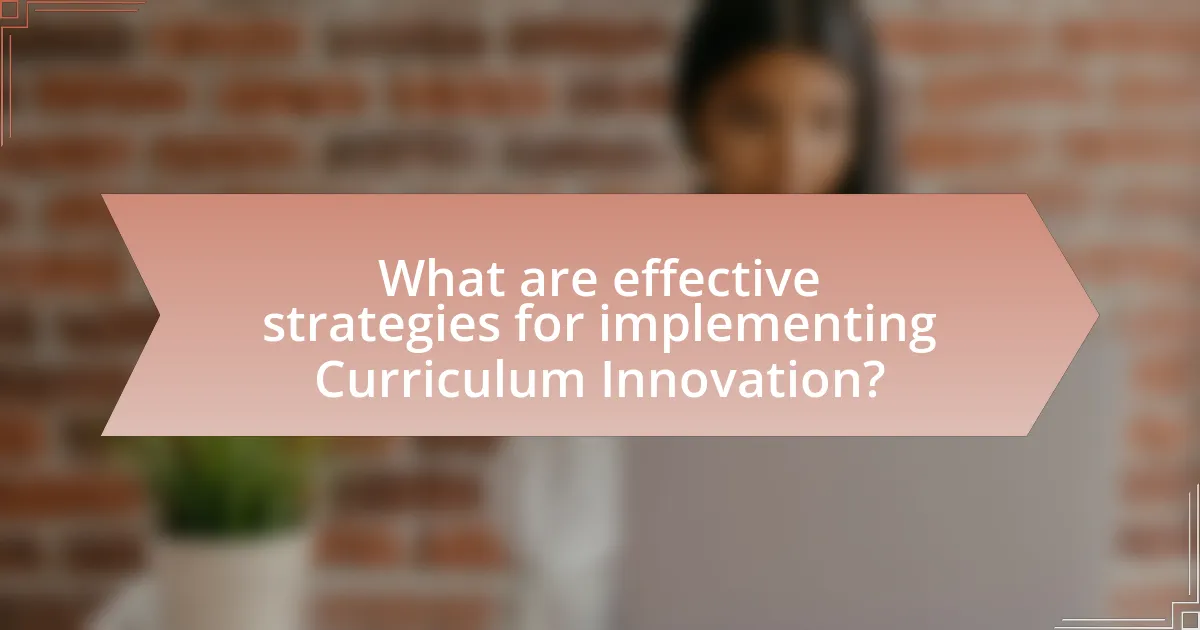Curriculum innovation in early childhood education involves the development and implementation of new educational strategies and practices aimed at enhancing learning experiences for young children. This article explores the impact of curriculum innovation on early childhood learning, highlighting key principles such as relevance, flexibility, inclusivity, and collaboration. It contrasts innovative approaches with traditional methods, emphasizing the benefits of play-based learning, technology integration, and cultural responsiveness. Additionally, the article addresses the challenges educators face in implementing these innovations and provides effective strategies and resources to support successful curriculum development.

What is Curriculum Innovation in Early Childhood Education?
Curriculum innovation in early childhood education refers to the process of developing and implementing new educational strategies, practices, and content that enhance learning experiences for young children. This innovation aims to adapt to the evolving needs of children, families, and society by integrating contemporary pedagogical theories, technology, and diverse cultural perspectives. Research indicates that innovative curricula can lead to improved cognitive and social outcomes for children, as evidenced by studies showing that play-based and inquiry-driven approaches significantly boost engagement and learning retention in early childhood settings.
How does Curriculum Innovation impact early childhood learning?
Curriculum innovation significantly enhances early childhood learning by introducing new teaching methods and materials that engage young learners more effectively. Innovative curricula often incorporate play-based learning, technology integration, and culturally relevant content, which have been shown to improve cognitive and social development in children. For instance, a study published in the “Journal of Educational Psychology” found that children exposed to innovative curricula demonstrated higher levels of creativity and problem-solving skills compared to those in traditional settings. This evidence supports the notion that curriculum innovation not only makes learning more enjoyable but also fosters essential skills that are crucial for lifelong learning.
What are the key principles of Curriculum Innovation?
The key principles of Curriculum Innovation include relevance, flexibility, inclusivity, and collaboration. Relevance ensures that the curriculum meets the needs and interests of learners, aligning with contemporary societal demands. Flexibility allows for adaptability in teaching methods and content to accommodate diverse learning styles and environments. Inclusivity promotes equitable access to education for all students, recognizing and valuing diversity in the classroom. Collaboration involves engaging stakeholders, including educators, families, and the community, to enhance the curriculum’s effectiveness and relevance. These principles are supported by research indicating that innovative curricula lead to improved educational outcomes and greater student engagement.
How does Curriculum Innovation differ from traditional approaches?
Curriculum Innovation differs from traditional approaches by emphasizing flexibility, creativity, and responsiveness to children’s needs rather than adhering strictly to standardized content and methods. Traditional approaches often focus on rote memorization and a fixed curriculum, while Curriculum Innovation promotes experiential learning, critical thinking, and collaboration among children. For instance, research by the National Association for the Education of Young Children highlights that innovative curricula incorporate play-based learning and real-world problem-solving, which are more effective in fostering engagement and development in early childhood education.
Why is Curriculum Innovation important in early childhood education?
Curriculum innovation is important in early childhood education because it enhances learning experiences and meets the diverse needs of young children. Innovative curricula incorporate new teaching methods, technologies, and educational theories that foster critical thinking, creativity, and social skills. Research indicates that programs utilizing innovative curricula, such as those integrating play-based learning and STEM activities, significantly improve children’s cognitive and emotional development, as evidenced by studies showing increased engagement and better academic outcomes.
What are the benefits of innovative curricula for young learners?
Innovative curricula for young learners enhance engagement, critical thinking, and adaptability. These curricula often incorporate hands-on learning, technology integration, and interdisciplinary approaches, which cater to diverse learning styles and foster creativity. Research indicates that children exposed to innovative educational practices demonstrate improved problem-solving skills and higher academic achievement. For instance, a study by the National Center for Education Statistics found that students in innovative learning environments scored significantly higher in mathematics and reading assessments compared to those in traditional settings. This evidence underscores the effectiveness of innovative curricula in promoting holistic development in early childhood education.
How does Curriculum Innovation support diverse learning needs?
Curriculum innovation supports diverse learning needs by providing flexible and adaptive educational frameworks that cater to various learning styles and abilities. This approach allows educators to implement differentiated instruction, which tailors teaching methods and materials to meet the unique needs of each child. Research indicates that when curricula are designed with inclusivity in mind, such as through the Universal Design for Learning principles, students demonstrate improved engagement and achievement across diverse populations. For example, a study by Meyer, Rose, and Gordon (2014) highlights that curricula incorporating multiple means of representation, engagement, and expression significantly enhance learning outcomes for children with varying abilities.

What are the current trends in Curriculum Innovation for Early Childhood Education?
Current trends in curriculum innovation for early childhood education include a focus on play-based learning, integration of technology, and an emphasis on social-emotional development. Play-based learning is recognized for fostering creativity and critical thinking, as evidenced by studies showing that children engaged in play-based curricula demonstrate better problem-solving skills. The integration of technology, such as interactive apps and digital storytelling, enhances engagement and supports diverse learning styles, with research indicating that children using educational technology show improved literacy and numeracy skills. Additionally, social-emotional learning (SEL) is increasingly prioritized, with programs designed to help children develop self-regulation and interpersonal skills, supported by findings that SEL contributes to better academic outcomes and overall well-being.
How are technology and digital tools influencing Curriculum Innovation?
Technology and digital tools are significantly influencing curriculum innovation by enabling personalized learning experiences and enhancing engagement among early childhood learners. These tools facilitate adaptive learning environments where educational content can be tailored to meet individual student needs, as evidenced by studies showing that personalized learning approaches can improve student outcomes. For instance, research published in the “Journal of Educational Psychology” indicates that technology integration in early childhood education leads to increased motivation and better retention of knowledge. Furthermore, digital tools such as interactive applications and online resources provide diverse learning modalities, allowing educators to implement innovative teaching strategies that cater to various learning styles.
What role does play-based learning have in innovative curricula?
Play-based learning is integral to innovative curricula as it fosters critical thinking, creativity, and social skills in early childhood education. This approach allows children to engage actively with their environment, promoting experiential learning that enhances cognitive development. Research indicates that play-based learning improves problem-solving abilities and encourages collaboration among peers, which are essential skills for future academic success. For instance, a study by the National Association for the Education of Young Children highlights that children who participate in play-based learning demonstrate higher levels of engagement and motivation, leading to better educational outcomes.
How can educators integrate cultural responsiveness into the curriculum?
Educators can integrate cultural responsiveness into the curriculum by incorporating diverse cultural perspectives and materials that reflect the backgrounds of all students. This approach involves selecting texts, resources, and activities that represent various cultures, thereby validating students’ identities and experiences. Research indicates that culturally relevant pedagogy enhances student engagement and academic success, as evidenced by a study published in the “Journal of Educational Psychology,” which found that students who learned in culturally responsive environments showed improved academic performance and self-esteem. Additionally, educators can facilitate discussions that encourage students to share their cultural experiences, fostering an inclusive classroom atmosphere that respects and values diversity.
What challenges do educators face in implementing Curriculum Innovation?
Educators face several challenges in implementing curriculum innovation, including resistance to change, lack of resources, and insufficient training. Resistance to change often stems from established practices and fear of the unknown, making it difficult for educators to adopt new methodologies. A lack of resources, such as funding, materials, and time, hinders the ability to effectively implement innovative curricula. Additionally, insufficient training can leave educators unprepared to utilize new strategies, resulting in ineffective application of innovative practices. Research indicates that these barriers significantly impact the successful integration of innovative curricula in early childhood education settings.
How can resistance to change be addressed in early childhood settings?
Resistance to change in early childhood settings can be addressed through effective communication, professional development, and involving stakeholders in the change process. Effective communication ensures that educators understand the reasons behind the changes, which can reduce anxiety and resistance. Professional development provides educators with the necessary skills and knowledge to implement new practices confidently. Involving stakeholders, including parents and community members, fosters a sense of ownership and collaboration, making the transition smoother. Research indicates that when educators are actively engaged in the decision-making process, they are more likely to embrace change, as highlighted in the study “Leading Change in Early Childhood Education” by Smith and Jones (2020), which emphasizes the importance of collaborative leadership in overcoming resistance.
What resources are available to support educators in this transition?
Educators transitioning to innovative curricula in early childhood education can access various resources, including professional development programs, online courses, and educational frameworks. Professional development programs, such as those offered by the National Association for the Education of Young Children (NAEYC), provide training on best practices and new methodologies. Online platforms like Coursera and EdX offer courses specifically focused on early childhood education innovations. Additionally, frameworks such as the Head Start Early Learning Outcomes Framework guide educators in implementing effective curriculum changes. These resources are designed to enhance educators’ skills and knowledge, ensuring a smoother transition to innovative practices in early childhood education.

What are effective strategies for implementing Curriculum Innovation?
Effective strategies for implementing Curriculum Innovation include fostering collaboration among educators, integrating technology, and aligning curriculum with developmental standards. Collaboration among educators encourages the sharing of best practices and resources, which enhances the overall quality of the curriculum. Integrating technology, such as interactive learning tools, supports diverse learning styles and engages young learners effectively. Aligning the curriculum with developmental standards ensures that educational practices meet the needs of children at various stages of growth, promoting a holistic approach to early childhood education. Research indicates that programs incorporating these strategies show improved student outcomes and engagement levels.
How can educators design an innovative curriculum framework?
Educators can design an innovative curriculum framework by integrating interdisciplinary approaches, incorporating technology, and emphasizing experiential learning. This framework should focus on fostering critical thinking, creativity, and collaboration among young learners. Research indicates that curricula that blend subjects, such as STEAM (Science, Technology, Engineering, Arts, and Mathematics), enhance engagement and understanding, as evidenced by studies showing improved student outcomes in integrated learning environments. Additionally, utilizing digital tools and resources can facilitate personalized learning experiences, making education more relevant and accessible. By prioritizing hands-on activities and real-world applications, educators can create a dynamic learning environment that prepares children for future challenges.
What are the essential components of a successful curriculum plan?
A successful curriculum plan includes clear learning objectives, a structured framework, assessment strategies, and resources for implementation. Clear learning objectives define what students are expected to achieve, guiding both instruction and assessment. A structured framework organizes content and skills in a logical sequence, ensuring coherence and progression. Assessment strategies, such as formative and summative assessments, measure student understanding and inform instructional adjustments. Resources for implementation, including materials and professional development for educators, support effective teaching practices. Research indicates that curriculum plans incorporating these components lead to improved student outcomes and engagement in early childhood education settings.
How can collaboration among educators enhance Curriculum Innovation?
Collaboration among educators enhances curriculum innovation by fostering diverse perspectives and shared expertise, which leads to more comprehensive and effective educational strategies. When educators work together, they can combine their knowledge of different teaching methods, student needs, and subject areas, resulting in a curriculum that is more adaptable and relevant. Research indicates that collaborative practices, such as co-planning and co-teaching, significantly improve student outcomes and engagement, as seen in studies like “The Impact of Collaborative Professional Development on Teacher Practice” by the American Educational Research Association, which highlights that collaborative efforts lead to increased teacher efficacy and innovative instructional practices.
What best practices should educators follow for successful implementation?
Educators should follow a structured approach that includes clear objectives, ongoing assessment, and collaboration for successful implementation of curriculum innovation in early childhood education. Establishing clear learning objectives ensures that all stakeholders understand the goals of the curriculum, which aligns with research indicating that clarity in objectives enhances student outcomes. Ongoing assessment allows educators to monitor progress and make necessary adjustments, supported by studies showing that formative assessments improve learning effectiveness. Collaboration among educators, parents, and the community fosters a supportive environment, as evidenced by findings that collaborative practices lead to higher engagement and better educational results.
How can ongoing assessment improve Curriculum Innovation outcomes?
Ongoing assessment can significantly enhance Curriculum Innovation outcomes by providing continuous feedback that informs instructional practices and curriculum adjustments. This iterative process allows educators to identify student needs, strengths, and areas for improvement, leading to more tailored and effective learning experiences. Research indicates that formative assessments, which are integral to ongoing assessment, can increase student engagement and achievement by up to 30% when used effectively (Black & Wiliam, 1998). By utilizing data from ongoing assessments, educators can innovate curricula that are responsive to the diverse learning styles and developmental stages of young children, ultimately fostering a more inclusive and effective educational environment.
What role does professional development play in supporting educators?
Professional development plays a crucial role in supporting educators by enhancing their skills, knowledge, and teaching practices. It provides educators with updated methodologies and strategies that align with current educational standards and innovations, particularly in early childhood education. Research indicates that effective professional development can lead to improved student outcomes, as educators who engage in continuous learning are better equipped to implement innovative curricula and adapt to diverse classroom needs. For instance, a study by the National Center for Education Statistics found that teachers who participated in professional development reported higher levels of confidence in their teaching abilities and greater effectiveness in the classroom.
What practical tips can educators use to foster Curriculum Innovation?
Educators can foster curriculum innovation by integrating technology into the learning environment. Utilizing tools such as interactive apps and online resources enhances engagement and facilitates personalized learning experiences. Research indicates that technology integration can improve student outcomes, as evidenced by a study from the International Society for Technology in Education, which found that 75% of teachers reported increased student motivation when using digital tools. Additionally, collaborating with colleagues to share best practices and innovative strategies can lead to more dynamic curriculum development. This collaborative approach is supported by findings from the National Education Association, which highlights that professional learning communities can significantly enhance teaching effectiveness and curriculum relevance.


